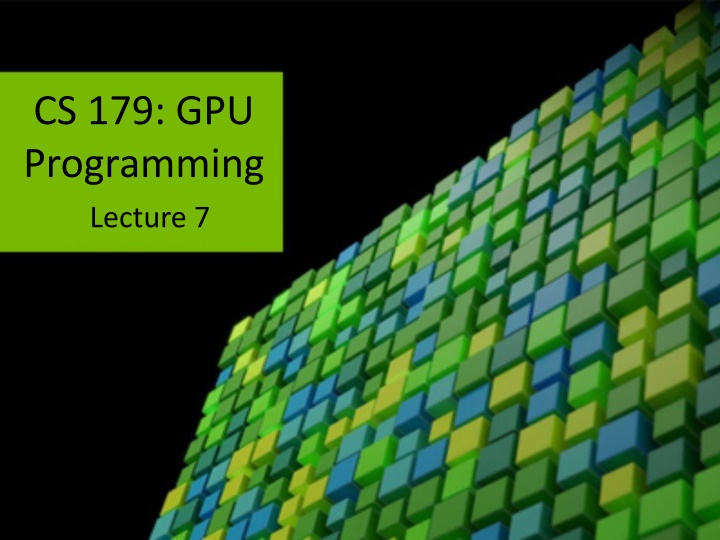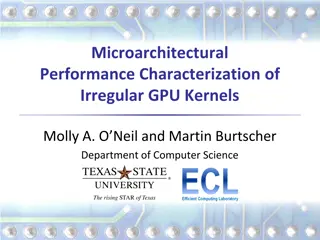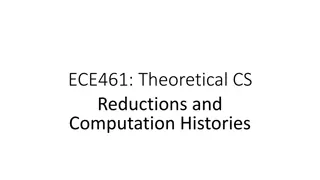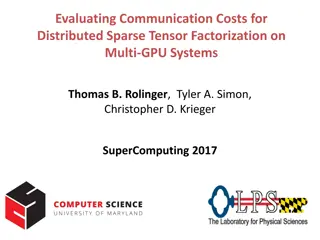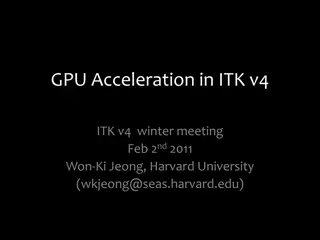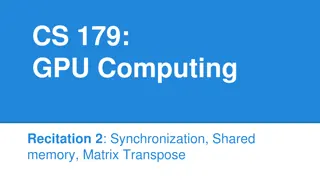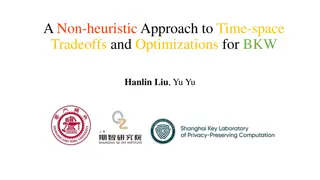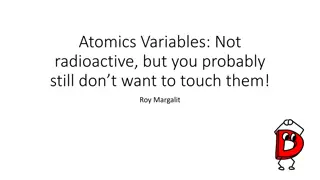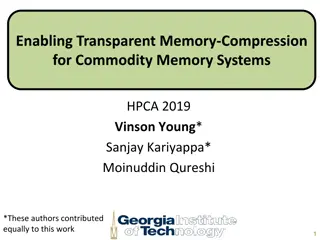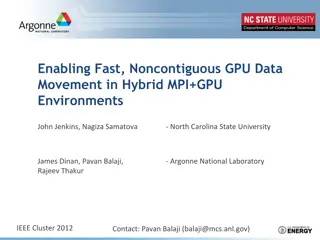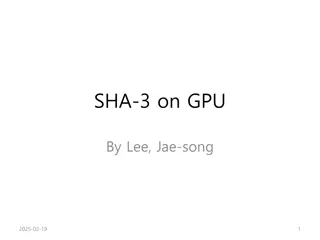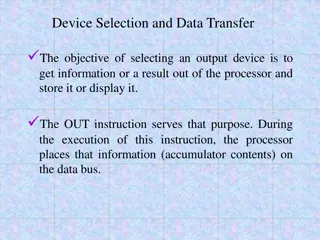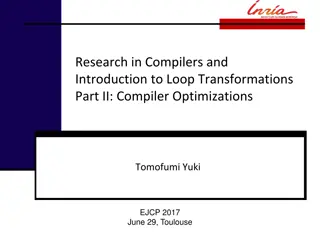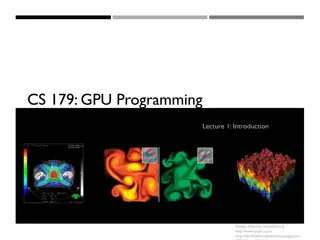GPU Programming Lecture 7: Memory Optimizations and GPU Reductions
This lecture delves into memory optimizations using different GPU caches, atomic operations, synchronization techniques, and advanced GPU-accelerated algorithms such as reductions for parallelizing non-intuitively parallelizable problems. Explore reductions for GPUs, properties of reduction operators, and the MapReduce framework.
Download Presentation

Please find below an Image/Link to download the presentation.
The content on the website is provided AS IS for your information and personal use only. It may not be sold, licensed, or shared on other websites without obtaining consent from the author.If you encounter any issues during the download, it is possible that the publisher has removed the file from their server.
You are allowed to download the files provided on this website for personal or commercial use, subject to the condition that they are used lawfully. All files are the property of their respective owners.
The content on the website is provided AS IS for your information and personal use only. It may not be sold, licensed, or shared on other websites without obtaining consent from the author.
E N D
Presentation Transcript
CS 179: GPU Programming Lecture 7
Last Week Memory optimizations using different GPU caches Atomic operations Synchronization with __syncthreads()
This week, Week 3 More advanced GPU-accelerable algorithms Reductions to parallelize problems that might not seem intuitively parallelizable Not the same as reductions in complexity theory or machine learning! Lots of technical meanings for Reduction see https://en.wikipedia.org/wiki/Reduction See https://en.wikipedia.org/wiki/Reduction_Operator
This Lecture -- Outline Reductions for GPUs Examples of GPU-accelerable algorithms: (To be used in combination for Quicksort!) Sum of array Prefix sum Stream compaction Sorting (quicksort)
GPU Reductions Again, see https://en.wikipedia.org/wiki/Reduction_Operator Commonly used in parallel programming to reduce all elements of an array to single result. Supposed to be associative and often (but not necessarily) commutative. Can be used in "Map Reduce" where reduction operator is applied (mapped) to all elements before they are reduced. Many reduction operators can be used for broadcasting, to distribute data to all processors.
Properties of Reduction Operator Allows many serial operations to be performed in parallel, reducing number of steps Helps break down full task into partial tasks. Calculates partial results to obtain final result. Stores results of partial tasks into private copies of the variable. These private copies are then merged into a shared copy at the end. An operator is a reduction operator for example, if: It can reduce an array to a single scalar value. (eg, adding all elements of array). The final result should be obtainable from the results of the partial tasks that were created. Satisfied for commutative and associative operators that are applied to all array elements. Some operators which satisfy these requirements are integer addition, multiplication, and some logical operators (and, or, etc.).
MapReduce, more advanced See https://en.wikipedia.org/wiki/MapReduce MapReduce is a framework for processing parallelizable problems across large datasets using a large number of computers Usually composed of three steps: Map: each worker node applies the map function to the local data, and writes the output to a temporary storage. A master node ensures that only one copy of the redundant input data is processed. Shuffle: worker nodes redistribute data based on the output keys (produced by the map function), such that all data belonging to one key is located on the same worker node. Reduce: worker nodes now process each group of output data, per key, in parallel. MapReduce allows for distributed processing of the map /reduction operations. Maps can be performed in parallel, when mapping operations are independent
Outline Examples of GPU-accelerable algorithms: Sum of array Prefix sum Stream compaction Sorting (quicksort)
Elementwise Integer Addition Problem: C[i] = A[i] + B[i] CPU code: float *C = malloc(N * sizeof(float)); for (int i = 0; i < N; i++) C[i] = A[i] + B[i]; GPU code: // assign device and host memory pointers, and allocate memory in host. Adds simultaneously across thread indices Adds simultaneously across thread indices! int thread_index = threadIdx.x + blockIdx.x * blockDim.x; while (thread_index < N) { C[thread_index] = A[thread_index] + B[thread_index]; thread_index += blockDim.x * gridDim.x; }
Simple Reduction Example Problem: SUM(A[]) CPU code: float sum = 0.0; for (int i = 0; i < N; i++) sum += A[i]; GPU Pseudocode: // set up device and host memory pointers // create threads and get thread indices // assign each thread a specific region to sum over // wait for all threads to finish running ( __syncthreads; ) // combine all thread sums for final solution
Naive Reduction Suppose we wished to accumulate our results
Naive Reduction Race conditions! Could load old value before new one (from another thread) is written out Thread-unsafe!
Naive (but correct) Reduction We could do a bunch of atomic adds to our global accumulator
Naive (but correct) Reduction But then we lose a lot of our parallelism Every thread needs to wait
Shared memory accumulation Right now, the only parallelism we get is partial sums per thread Idea: store partial sums per thread in shared memory If we do this, we can accumulate partial sums per block in shared memory, and THEN atomically add a much larger sum to the global accumulator
Shared memory accumulation It doesn t seem particularly efficient to have one thread per block accumulate for the entire block Can we do better?
Binary tree reduction Thread 0 atomicAdd s this to global result
Binary tree reduction Use __syncthreads() before proceeding!
Binary tree reduction Warp Divergence! Odd threads won t even execute.
Non-divergent reduction Shared Memory Bank Conflicts! 2-way on 1st iteration, 4-way on 2nditeration,
Sequential addressing Automatically resolves bank conflicts!
Sum Reduction More improvements possible (gets crazy!) Optimizing Parallel Reduction in CUDA (Harris) Code examples! Moral: Different type of GPU-accelerated problems Some are parallelizable in a different sense More hardware considerations in play
Outline GPU-accelerated: Sum of array Prefix sum See https://en.wikipedia.org/wiki/Prefix_sum Stream compaction Sorting (quicksort)
Prefix Sum Given input sequence x[n], produce sequence ? 1 ? ? = ? ? ?=0 e.g. x[n] = (1, 1, 1, 1, 1, 1, 1) -> y[n] = (0, 1, 2, 3, 4, 5, 6) e.g. x[n] = (1, 2, 3, 4, 5, 6) -> y[n] = (0, 1, 3, 6, 10, 15)
Prefix Sum Given input sequence x[n], produce sequence ? 1 ? ? = ? ? ?=0 e.g. x[n] = (1, 2, 3, 4, 5, 6) -> y[n] = (0, 1, 3, 6, 10, 15) Recurrence relation: ? ? = ? ? 1 + ? ?
Prefix Sum Recurrence relation: ? ? = ? ? 1 + ? ? Is it parallelizable? Is it GPU-accelerable? Recall: ? ? = ? ? + ? ? 1 + + ?[? ? 1 ] Easily parallelizable! ? ? = ? ? ? + 1 ? ? ? 1 Not so much
Prefix Sum Recurrence relation: ? ? = ? ? 1 + ? ? Is it parallelizable? Is it GPU-accelerable? Goal: Parallelize using a reduction-like strategy
Prefix Sum sample code (up-sweep) [1, 3, 3, 10, 5, 11, 7, 36] [1, 3, 3, 10, 5, 11, 7, 26] [1, 3, 3, 7, 5, 11, 7, 15] Original array [1, 2, 3, 4, 5, 6, 7, 8] for d = 0 to (log2n) -1 do for all k = 0 to n-1 by 2d+1 in parallel do x[k + 2d+1 1] = x[k + 2d -1] + x[k + 2d] We want: [0, 1, 3, 6, 10, 15, 21, 28] (University of Michigan EECS, http://www.eecs.umich.edu/courses/eecs570/hw/parprefix.pdf
Prefix Sum sample code (down-sweep) Original: [1, 2, 3, 4, 5, 6, 7, 8] [1, 3, 3, 10, 5, 11, 7, 36] [1, 3, 3, 10, 5, 11, 7, 0] [1, 3, 3, 0, 5, 11, 7, 10] x[n-1] = 0 for d = log2(n) 1 down to 0 do for all k = 0 to n-1 by 2d+1 in parallel do t = x[k + 2d 1] x[k + 2d 1] = x[k + 2d] x[k + 2d] = t + x[k + 2d] [1, 0, 3, 3, 5, 10, 7, 21] Final result [0, 1, 3, 6, 10, 15, 21, 28] (University of Michigan EECS, http://www.eecs.umich.edu/courses/eecs570/hw/parprefix.pdf
Prefix Sum (Up-Sweep) Use __syncthreads() before proceeding! Original array (University of Michigan EECS, http://www.eecs.umich.edu/courses/eecs570/hw/parprefix.pdf
Prefix Sum (Down-Sweep) Use __syncthreads() before proceeding! Final result (University of Michigan EECS, http://www.eecs.umich.edu/courses/eecs570/hw/parprefix.pdf
Prefix Sum Bank conflicts galore! 2-way, 4-way,
Prefix Sum Bank conflicts! 2-way, 4-way, Pad addresses! (University of Michigan EECS, http://www.eecs.umich.edu/courses/eecs570/hw/parprefix.pdf
Prefix Sum https://developer.nvidia.com/gpugems/gpugems 3/part-vi-gpu-computing/chapter-39-parallel- prefix-sum-scan-cuda -- See Link for a More In- Depth Explanation of Up-Sweep and Down- Sweep All of GPU Gems 3 available to download here! See also Ch8 of textbook (Kirk and Hwu) for a more build-up and motivation for the up-sweep and down-sweep algorithm (like we did for the array sum)
Outline GPU-accelerated: Sum of array Prefix sum Stream compaction (to be used for Quicksort!) Sorting (quicksort)
Stream Compaction Problem: Given array A, produce sub-array of A defined by Boolean condition e.g. given array: 2 5 1 4 6 3 Produce array of numbers > 3 5 4 6 Will use for implementing Quicksort on GPUs!
Stream Compaction Given array A: 2 5 1 4 6 3 GPU kernel 1: Evaluate boolean condition, Array M: 1 if true, 0 if false 0 1 0 1 1 0 GPU kernel 2: Cumulative sum of M (denote S) 0 1 1 2 3 3 GPU kernel 3: At each index, if M[idx] is 1, store A[idx] in output at position (S[idx] - 1) 5 4 6
Outline GPU-accelerated: Sum of array Prefix sum Stream compaction Sorting (quicksort) See https://en.wikipedia.org/wiki/Quicksort
GPU-accelerated quicksort Quicksort: Divide-and-conquer algorithm Partition array along chosen pivot point Sequential partition Pseudocode: quicksort(A, loIdx, hiIdx): if lo < hi: pIdx := partition(A, loIdx, hiIdx) quicksort(A, loIdx, pIdx - 1) quicksort(A, pIdx + 1, hiIdx)
GPU-accelerated partition Given array A: 2 5 1 4 6 3 Choose pivot (e.g. 3) Stream compact on condition: 3 2 1 Store pivot 2 1 3 Stream compact on condition: > 3 (store with offset) 2 1 3 5 4 6
GPU acceleration details Synchronize between calls of the previous algorithm Continued partitioning/synchronization on sub-arrays results in sorted array
Final Thoughts Less obviously parallelizable problems Hardware matters! (synchronization, bank conflicts, ) Resources: GPU Gems, Vol. 3, Ch. 39 Highly Recommend Reading This Guide to CUDA Optimization, with a Reduction Example Kirk and Hwu Chapters 7-12 for more parallel algorithms
